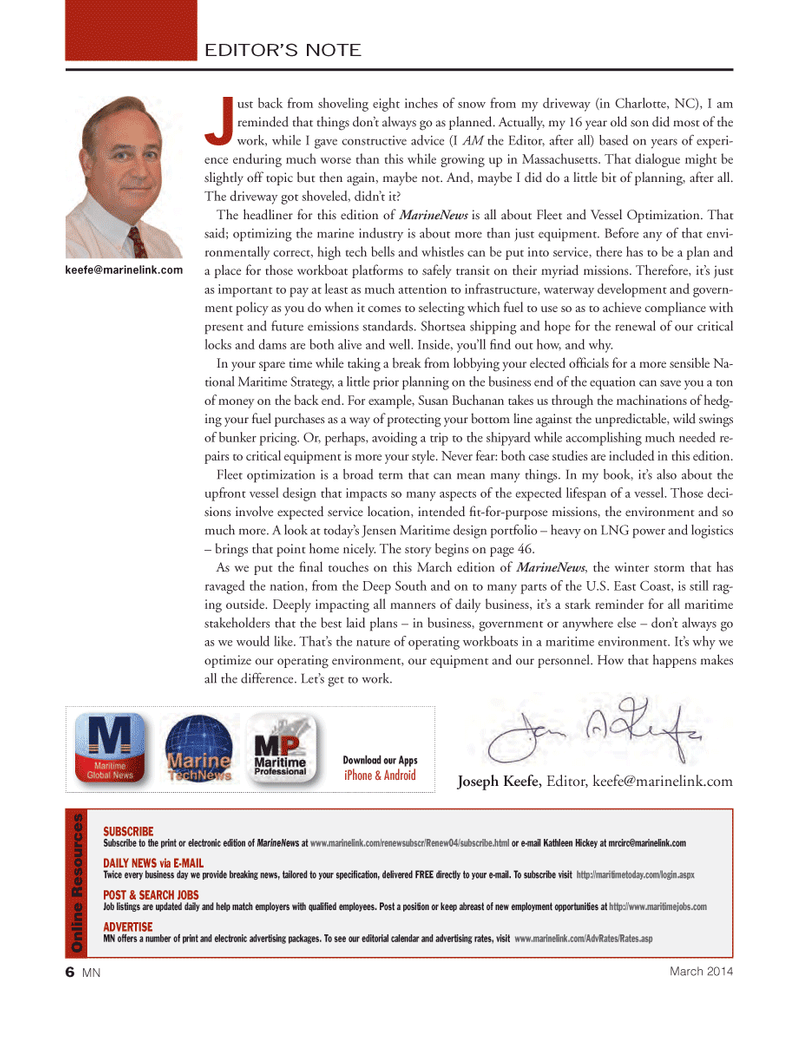
Page 6: of Marine News Magazine (March 2014)
Fleet & Vessel Optimization
Read this page in Pdf, Flash or Html5 edition of March 2014 Marine News Magazine
SUBSCRIBE
Subscribe to the print or electronic edition of MarineNews at www.marinelink.com/renewsubscr/Renew04/subscribe.html or e-mail Kathleen Hickey at [email protected]
DAILY NEWS via E-MAIL
Twice every business day we provide breaking news, tailored to your specifi cation, delivered FREE directly to your e-mail. To subscribe visit http://maritimetoday.com/login.aspx
POST & SEARCH JOBS
Job listings are updated daily and help match employers with qualifi ed employees. Post a position or keep abreast of new employment opportunities at http://www.maritimejobs.com
ADVERTISE
MN offers a number of print and electronic advertising packages. To see our editorial calendar and advertising rates, visit www.marinelink.com/AdvRates/Rates.asp
Online Resour ces
EDITOR’S NOTE
J ust back from shoveling eight inches of snow from my driveway (in Charlotte, NC), I am reminded that things don’t always go as planned. Actually, my 16 year old son did most of the work, while I gave constructive advice (I AM the Editor, after all) based on years of experi- ence enduring much worse than this while growing up in Massachusetts. That dialogue might be slightly off topic but then again, maybe not. And, maybe I did do a little bit of planning, after all.
The driveway got shoveled, didn’t it?
The headliner for this edition of MarineNews is all about Fleet and Vessel Optimization. That said; optimizing the marine industry is about more than just equipment. Before any of that envi- ronmentally correct, high tech bells and whistles can be put into service, there has to be a plan and a place for those workboat platforms to safely transit on their myriad missions. Therefore, it’s just as important to pay at least as much attention to infrastructure, waterway development and govern- ment policy as you do when it comes to selecting which fuel to use so as to achieve compliance with present and future emissions standards. Shortsea shipping and hope for the renewal of our critical locks and dams are both alive and well. Inside, you’ll fi nd out how, and why.
In your spare time while taking a break from lobbying your elected offi cials for a more sensible Na- tional Maritime Strategy, a little prior planning on the business end of the equation can save you a ton of money on the back end. For example, Susan Buchanan takes us through the machinations of hedg- ing your fuel purchases as a way of protecting your bottom line against the unpredictable, wild swings of bunker pricing. Or, perhaps, avoiding a trip to the shipyard while accomplishing much needed re- pairs to critical equipment is more your style. Never fear: both case studies are included in this edition.
Fleet optimization is a broad term that can mean many things. In my book, it’s also about the upfront vessel design that impacts so many aspects of the expected lifespan of a vessel. Those deci- sions involve expected service location, intended fi t-for-purpose missions, the environment and so much more. A look at today’s Jensen Maritime design portfolio – heavy on LNG power and logistics – brings that point home nicely. The story begins on page 46.
As we put the fi nal touches on this March edition of MarineNews, the winter storm that has ravaged the nation, from the Deep South and on to many parts of the U.S. East Coast, is still rag- ing outside. Deeply impacting all manners of daily business, it’s a stark reminder for all maritime stakeholders that the best laid plans – in business, government or anywhere else – don’t always go as we would like. That’s the nature of operating workboats in a maritime environment. It’s why we optimize our operating environment, our equipment and our personnel. How that happens makes all the difference. Let’s get to work. [email protected]
Joseph Keefe, Editor, [email protected]
Download our Apps iPhone & Android 6 MN
March 2014
MN MAR14 Layout 1-17.indd 6 2/21/2014 3:15:11 PM

 5
5

 7
7
